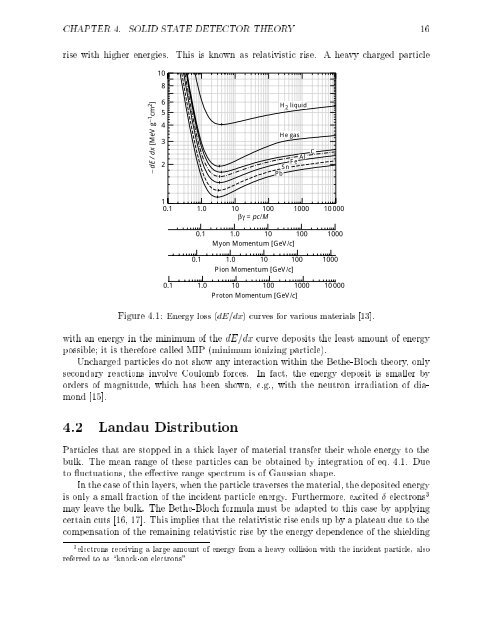Diamond Detectors for Ionizing Radiation - HEPHY
Diamond Detectors for Ionizing Radiation - HEPHY
Diamond Detectors for Ionizing Radiation - HEPHY
You also want an ePaper? Increase the reach of your titles
YUMPU automatically turns print PDFs into web optimized ePapers that Google loves.
CHAPTER 4. SOLID STATE DETECTOR THEORY 16<br />
rise with higher energies.<br />
This is known as relativistic rise. A heavy charged particle<br />
10<br />
8<br />
− dE/dx [MeV g −1 cm 2 ]<br />
6<br />
5<br />
4<br />
3<br />
2<br />
H 2 liquid<br />
He gas<br />
Fe<br />
Sn<br />
Pb<br />
Al<br />
C<br />
1<br />
0.1<br />
1.0 10 100 1000 10 000<br />
βγ = pc/M<br />
0.1<br />
0.1<br />
1.0 10 100 1000<br />
Myon Momentum [GeV/c]<br />
1.0 10 100 1000<br />
Pion Momentum [GeV/c]<br />
0.1<br />
1.0 10 100 1000 10 000<br />
Proton Momentum [GeV/c]<br />
Figure 4.1: Energy loss (dE=dx) curves <strong>for</strong> various materials [13].<br />
with an energy in the minimum of the dE=dx curve deposits the least amount of energy<br />
possible; it is there<strong>for</strong>e called MIP (minimum ionizing particle).<br />
Uncharged particles do not show any interaction within the Bethe-Bloch theory, only<br />
secondary reactions involve Coulomb <strong>for</strong>ces. In fact, the energy deposit is smaller by<br />
orders of magnitude, which has been shown, e.g., with the neutron irradiation of diamond<br />
[15].<br />
4.2 Landau Distribution<br />
Particles that are stopped in a thick layer of material transfer their whole energy to the<br />
bulk. The mean range of these particles can be obtained by integration of eq. 4.1. Due<br />
to uctuations, the eective range spectrum is of Gaussian shape.<br />
In the case of thin layers, when the particle traverses the material, the deposited energy<br />
is only a small fraction of the incident particle energy. Furthermore, excited electrons 3<br />
may leave the bulk. The Bethe-Bloch <strong>for</strong>mula must be adapted to this case by applying<br />
certain cuts [16, 17]. This implies that the relativistic rise ends up by a plateau due to the<br />
compensation of the remaining relativistic rise by the energy dependence of the shielding<br />
3 electrons receiving a large amount of energy from a heavy collision with the incident particle, also<br />
referred to as \knock-on electrons"












